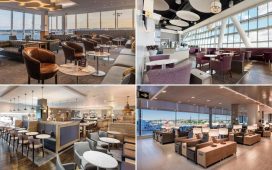Hiking over the rocks near Tujetsch, I was surprised to find a lighthouse. My surprise wasn’t due to its appearance: the lighthouse was modest in size and rusty red, with the squat proportions of a wine cork, and barely visible through a jacket of mist. What made it extraordinary was its location: perched atop a mountain in Switzerland, more than 200 miles from the nearest coastline and 2,000 metres above sea level.
The design looked familiar and, as I walked closer, I realised why. The lighthouse was (a sign explained) a near-replica of one I had seen a few months previously hundreds of miles away, on the Dutch coast at the Hook of Holland. The twin lighthouses were, in a sense, opposing poles: one near the source of the River Rhine in the Alps, the other where the same river ends at the North Sea. As such, this spot marked a natural end to my journey along the Rhine, all the way from river mouth to source, from one lighthouse to the other.
Before setting out along the Rhine I’d always thought of it as a thoroughly German river, in much the same way that the Thames is indisputably British and the Seine quintessentially French. In truth, the Rhine is multinational. Following the river, I’d traversed not only Switzerland, the Netherlands and Germany, but also France, Austria and Liechtenstein, and through cities including Basel, Strasbourg, Bonn, Düsseldorf and Rotterdam. Along the way, the river itself had changed from a wide channel flanked by meadows and cathedrals to a tumbling mountain stream. Charging almost 800 miles across Europe, the Rhine changed its appearance as often as a pantomime dame.

Cycling, walking, swimming and boating my way along the river, I’d found it littered with odd and interesting sights, from underground nuclear bunkers to thunderous waterfalls, nudist spas and glittering modern skyscrapers.
I also learned how the Rhine has long been one of Europe’s most important highways, moats and natural resources, and has played a pivotal role in the history of the places it passes.
Two thousand years ago, the northern section of the river served as the outer boundary of the Roman Empire, a liquid frontier which kept out would-be migrants more effectively than any wall. Later, the river also served as an important highway for trade, generating enormous wealth for everyone from Frisians and Vikings to the merchants of the Hanseatic League and Golden Age Amsterdam.

Later still, terrible wars were triggered partly by rivalry over the coal and steel of the Rhineland. The West German capital of Bonn found itself on the frontlines of the cold war, while the Franco-German border city of Strasbourg emerged as one of the headquarters of the European Union.
More happily, the river has also played a central role in shaping Europe’s culture. Perhaps the most famous example of this can be found along the “Romantic Rhine” in western Germany, which I’d travelled along before arriving at the alpine lighthouse. This area is known for its beauty, and it didn’t disappoint. Heading south from Koblenz on an open-topped boat, I passed through a seemingly endless series of pretty riverside towns, vineyards and forested peaks. Rocky islands were decorated with whitewashed chapels, and almost every hilltop had a crumbling castle. It looked like the kind of place where Shrek might live happily ever after.

I wasn’t the first visitor to appreciate the Rhine’s beauty, of course. In the 19th century, as German patriots searched for symbols around which their nascent country could unite, the middle Rhine emerged as a potent source of pride. Just as the British national identity was (and is) defined partly by the country’s island geography, the emerging German national identity was, for many patriots, epitomised by Germany’s wild spaces. In that context, the Rhine was a cleansing force in an era of industrialisation; a unifying belt which tied states together, and a symbol of an idealised past where heroism prevailed. “Memories of what the Germans once were and could be in the future are evoked nowhere so clearly as on the Rhine,” Friedrich Schlegel wrote in 1803.

Monuments, statues and castles were erected along the river, and plays and operas penned about it. Wagner, Goethe, Beethoven, Turner and Byron were all inspired by trips along it. Mary Shelley wrote Frankenstein after a visit to a Rhine town where a local man was rumoured to be experimenting on dead bodies, and both the car and the bicycle were invented on the river’s banks.
Brits on Grand Tours of the continent were also enthralled by the sight of attractions like the famous Lorelei rock. “Oh! This, to me, were earthly bliss,” an ecstatic James Blake wrote after his visit in 1840. “My nature sure was made for this!”
Today, such enthusiasm for a river can be hard to imagine. In Europe, most of us now work in office buildings rather than in mills or factories powered by waterwheels, and we travel by plane, car or train rather than riverboat. Rivers themselves have been tamed, with islands removed and banks overlaid with stone. In that context, even mighty waterways like the Rhine, Thames or Elbe are seen as nice places to walk a dog or have a drink after work, but not as exciting, important things.

This is a shame, because in many ways rivers are still crucial. North of the Romantic Rhine, I spent a few weeks exploring the area around the German cities of Duisburg and Düsseldorf, where the rivers Rhine and Ruhr merge. The Ruhrgebiet conurbation isn’t always attractive – in many places factory chimneys outnumber trees, and the air tastes like burnt metal. The region has long been one of the engines of the German economy, thanks to the vast coal mines and steelworks clustered there. In the late 1800s and early 1900s, cities like Duisburg developed so fast that when soldiers came home on leave, they had trouble finding their homes. Today, the closure of mines and factories has destroyed thousands of jobs, and some former industrial sites are now tourist attractions, with skating rinks and climbing walls installed in place of furnaces and shipyards. However, the Rhine remains part of the lifeblood of the region’s economy.
Rotterdam, at the mouth of the river, is by far the biggest port in Europe, handling more than twice as much trade as the ports at Southampton and Felixstowe combined.
Finally, I was also surprised to learn the extent to which the Rhine still shapes the identity of the people who live near it. This was perhaps most obvious at the start of my trip, travelling through the Dutch polders and to cities like Dordrecht and Utrecht. Here in the Rhine delta, traces of water’s influence are everywhere; from the windmills which were built to pump out water from boggy fields, to the cheese and tulips produced on the fertile land left behind.
The omnipresent water even shaped the Netherlands’ political system: with one town’s safety dependent on others maintaining their flood defences, it’s only natural that politics should be more like a business negotiation than a bloodsport.

Elsewhere, the Rhine also remains a powerful symbol. The river still forms part of the borders of five countries, and helps tie neighbouring countries together, giving them a shared interest in keeping trade free and the water clean.
The modern Rhineland isn’t without its challenges – last summer, rising temperatures meant the water levels in the river were so low that shipping ground to a halt, denting Germany’s economy and causing fuel shortages in the Netherlands. Overall, though, the outlook remains good. Business is still booming and tourism thrives. After an international clean-up project, the Rhine’s waters are the cleanest in decades. And after centuries of conflict across the river, war between France and Germany is almost certain never to happen.
To a Brit in the age of Brexit, the places through which the Rhine flows often appear to represent modern Europe at its best: internationalist, industrious and interconnected; blending cultures and influences as seamlessly as the waters from its tributaries. Standing by one of the lighthouses and gazing up or downstream, it’s hard not to feel awed by all the ways in which one river has shaped history. “The Rhine,” Victor Hugo wrote, “is unique; it combines the qualities of every river … Mysterious, like the Nile; spangled with gold, like an American river; and, like a river of Asia, abounding with phantoms and fables.”
A man I met on a boat near Arnhem was even more succinct. “The Rhine,” he said, “connects us all.”
Ben Coates is author of The Rhine: Following Europe’s Greatest River from Amsterdam to the Alps, available for £8.79 from the Guardian Bookshop
Excursions and activities on the Rhine
Cycle the Green Heart

The “Groene Hart” (Green Heart) of the Netherlands is as Dutch as a landscape could be: flat green fields, ancient windmills, dairy cows and dozens of rivers which form part of the Rhine delta. To get a taste of it, rent a bicycle in Gouda or Dordrecht and cycle east, stopping in an ancient village like Oudewater for lunch, cheese tasting or a glass or three of Heineken.
• holland-cycling.com
Carnival in Cologne

The Rhine isn’t all pretty forests and castles – the cities of the German Rhineland are known for their raucous carnivals. Visit Cologne during Carnival (20-28 Feb 2020) or the Christopher Street Day parade (6-8 July 2019) for a wild day out – but don’t expect much sleep.
• cologne.de
Cruise
It’s not exactly off the beaten track, but a “Romantic Rhine” boat cruise is still one of the best ways to explore the river at its most beautiful. Countless options are available, from weeks-long luxury cruises to one-hour ferry rides. The prettiest section is between Koblenz and Bingen, where there’s an ancient castle on almost every hilltop.
• kdrhine.com
Swim the Rhine in Basel

Basel is one of Europe’s most picturesque cities, with the river carving right through its centre. The best way to see the old town is by swimming past it in the crystal clear river, either during the annual Basel Rhine Swim or at your own pace.
• basel.com
Lake Constance
One of the largest lakes in Europe, Lake Constance (or Bodensee) bulges from the Rhine like a giant bead on a string. To explore it, go island-hopping by ferry from the Swiss town of Konstanz east towards Austria, with a view of the Alps on the way. Or, if your budget allows, ride an airship high over the German part of the lake.
• zeppelin-nt.de
Looking for a holiday with a difference? Browse Guardian Holidays to see a range of fantastic trips














